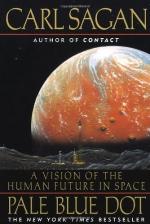
|
1. How does Saga claim that human beings expressed their desire to wander as civilization grew?
Sagan claims that as civilization grew, human beings expressed their desire to explore through stories, symbols, and religion.
2. How did ancient people know about the planets?
Ancient people knew about five of the planets because they were visible to the naked eye, and they moved in complex patterns, unlike the fixed motion of the stars.
3. What planets had been explored by human beings, at the time of the writing of this book?
At the time of the writing of this book, all of the planets from Mercury to Saturn has been explored remotely by human beings.
4. What was Sagan's involvement in the passage of Mars by the Viking probe?
The passage of Mars by the Viking probe was very important to Sagan, who participated in the experimental data gathering and interpretation to such a degree that he felt he was "living" on Mars during the month of Viking's passage.
(read all 60 Short Essay Questions and Answers)
|
This section contains 2,544 words (approx. 9 pages at 300 words per page) |

|




